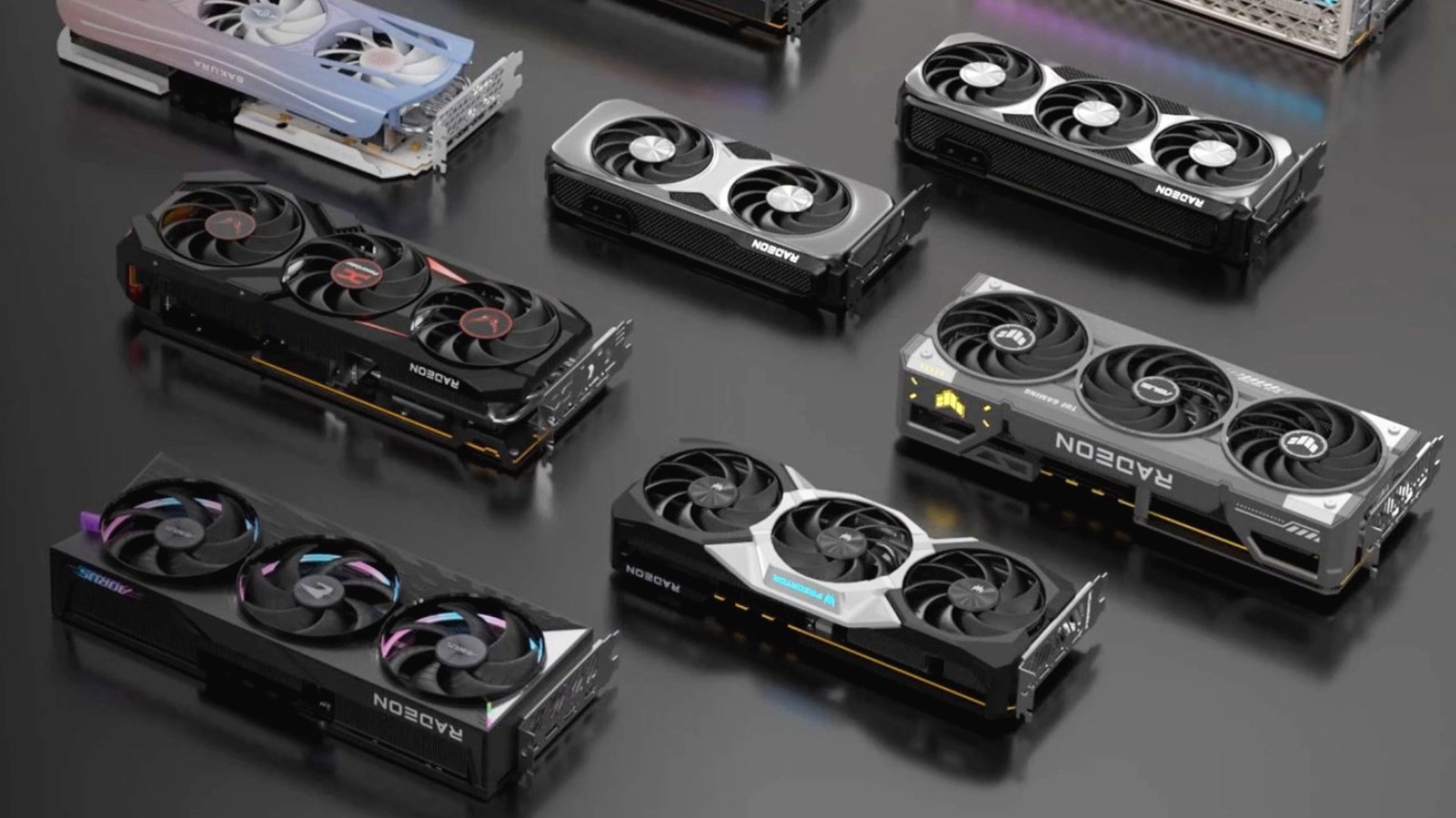
Whenever there’s a launch of a new graphics card, you’re almost immediately bombarded with technical talk about ray tracing, upscaling, and VRAM capacity. All of that is important, but what GPU you buy ultimately comes down to two things: a reasonable price and good performance. AMD’s mid-range RX 9070 XT delivers on both of those fronts, but it is hard to find at its recommended list price (MSRP) of $600. When you’re trying to choose from the best graphics card brands, finding a 9070 XT at MSRP is even more difficult, as high-end variants are significantly more expensive.
This market dynamic shoves the 9070 XT into a more premium price bracket, and it has stiffer competition in that situation. If the 9070 XT ends up costing $700 to $900, you’re better off buying the Nvidia alternative. On the other hand, there are also cards that are a tier or two down that can save you money without sacrificing too much performance.
While it may be a difficult time to upgrade your graphics card because of all this confusion, we’ll help you cut through all the chaos. We’re looking at five viable alternatives to the 9070 XT, evaluating them on real performance, their actual pricing, and tangible features.
There are two versions of the 5060 Ti: 8GB and 16GB. Our previous coverage shows that 8GB of VRAM isn’t enough in most cases, especially if you play at higher resolutions with ray tracing. The 16GB 5060 Ti is the one to go for, and it’s a very decent mainstream card for 1440p gaming.
In Techspot’s comparison between the 5060 Ti and its closest competitor, the 9060 XT, the Nvidia card beat the AMD card with an average 9% lead at native 1440p. PCMag’s tests showed that it also won in content creation tasks, as it showed better performance in creator benchmarks like Blender and PugetBench. It was also faster in AI benchmarks.
However, the 9060 XT 16GB has a cheaper MSRP of $350, and real-world pricing is under $400 at the time of writing. Nvidia’s 5060 Ti 16GB has an MSRP of $380, and often costs $450 or higher. The 5060 Ti is still justifiable, especially if you care about Nvidia’s DLSS upscaling feature, AI performance, and content creation.
Hardware Unboxed’s coverage showed that the 5060 Ti delivers an average of 76 FPS at 1440p. Performance was even better in Esports titles like Counter-Strike 2, where the 5060 Ti got close to 400 FPS at 1440p with medium settings. For the price, that’s a very reasonable result for a 60-tier card. If this card meets your performance needs, it’s a great, cheaper alternative to the 9070 XT.
The AMD Radeon RX 9070 is often overlooked, mainly because it performs worse than its XT version and isn’t significantly cheaper either. However, if you find yourself in a situation where the XT version is inflated and you can get the non-XT for significantly cheaper, the regular RX 9070 is the better purchase.
Techspot’s review of the RX 9070 pinned the Radeon card as 8% slower on average at 1440p. With a bit of fine-tuning (light overclocking, undervolting, or simply dropping in-game settings), you may be able to get even closer to the performance of the XT version. What’s more important is that this card was 4% faster at 1440p than its closest competitor, the Nvidia RTX 5070.
The FSR 4 upscaler may not be as widely available in games as Nvidia’s DLSS 4, but it performs well when the option is present. A major problem with this card, however, is its wildly unpredictable pricing.
When it’s priced close to the 5070 or lower than the 9070 XT, it’s the better value. That’s often not the case. In real-world pricing, it’s almost always close to the 9070 XT and pricier than the 5070. Additionally, the 5070’s DLSS 4 upscaling is better than AMD’s FSR 4, making the 9070 even less attractive at a higher price. At the time of writing, pricing varies between $600-$700. It’s a decent purchase at $600, but if it’s any higher, you should look towards the 9070 XT or 5070/5070 Ti.
Similar to the RTX 5060 Ti, AMD sells 8GB and 16GB versions of the Radeon RX 9060 XT. If you care about high-resolution gaming, ray tracing, and upscaling, get the 16GB version, as 8GB will limit your performance. The 16GB version is arguably the best value for most gamers, as it delivers respectable 1440p performance and fantastic 1080p performance at a cheap price.
A review from Tom’s Hardware showed that the 9060 XT delivered an average of 58 FPS at 1440p, while the 5060 Ti delivered 62 FPS. That’s not a significant difference, and when you factor in the lower price point, the 9060 XT is the better value. The 9060 XT 16GB often costs around $400, while the 5060 Ti costs $450 or higher, at the time of writing. You’re not missing out on any significant performance with the 9060XT. The only reason to get the 5060 Ti is if you care about content creation, AI workloads, or DLSS 4. For raw gaming performance, the 9060 XT is the better value.
It’s worth mentioning that this card is one tier down from the 9070 XT. As such, the performance is much lower. But when you’re dealing with inflated prices, it’s hard to ignore a good deal. The 9060 XT will give you excellent 1080p performance, and you can still play most games at 1440p with medium to high settings. It’s a sacrifice, sure, but not a very significant one.
If both the 9070 and 9070 XT are currently too expensive in your region, the RTX 5070 is your best bet to save money without losing too much performance. It has great performance at native 1440p, excellent upscaling technology thanks to DLSS 4, and good ray tracing performance. The only real downside is that it has 12GB of VRAM, which is lower than the equivalent Radeon cards.
Tom’s Hardware’s comparison between the 5070 and RX 9070 showed that the RTX 5070 was 8% slower than the RX 9070, so you can expect it to be even slower than the 9070 XT. Even then, this is the better card in terms of value while looking at inflated pricing. At the time of writing, the RX 9070’s average price is between 600-700, while the 9070 XT is around $700 or above. In stark contrast, the 5070’s MSRP is $550, and real-world pricing is close to that number.
This all sounds very confusing and incredibly nuanced, but you have to blame scalpers and the inflated GPU market. In normal circumstances, the 9070 would be the clear winner here. But pricing history over a couple of months dictates that the 9070 often costs $100-$150 more. For $550-$600, the 5070 delivers good 1440p performance as a mid-range card, making it the card to go for if that’s your budget. But you feel like you need 16GB of VRAM, then you’ll have to splurge on a 9070/9070XT or 5070 Ti.
In a different post, we mentioned that the RTX 5070 Ti is one of those cards that don’t have a good price-to-performance ratio. These days, you can readily find the 5070 Ti close to its real price of $750. That makes it a viable alternative to the 9070 XT, especially if the AMD card is selling above MSRP. Arguably, the 5070Ti is the best mid-range to high-end card for most people, as cards like the 5080/5090 cost too much for the average consumer.
This one features 16GB of VRAM and a 256-bit bus width. Both of these numbers are higher than its younger brother, the RTX 5070. Having a good amount of VRAM is essential these days, as many Triple-A games tend to struggle with performance when you’re playing on ultra settings with less than 16GB. The higher bus width also enables more bandwidth, which in turn helps performance.
When it comes to real-world performance, Techspot’s findings indicated that the 5070 Ti was 5% faster than the 9070 XT. That’s not an impressive margin, but you have to look at the bigger picture. If the 9070 XT is close to the price of an RTX 5070 Ti in your region, it’s a no-brainer to get the 5070 Ti.
As benchmarked by Gamers Nexus, the 5070Ti not only showed better raw performance, but also better upscaling and ray tracing performance. All these factors make the 5070 Ti a more well-rounded card than the 9070 XT.
Recommending a graphics card gets more difficult with each passing year. You can’t judge a graphics card just based on raw performance or MSRP anymore. Real-world pricing, realistic performance with and without upscaling, and the overall featureset are all important to consider.
Our hunt for 9070 XT alternatives began by searching for cards that land in the $500-$800 “mid-range” price bracket. We then evaluated how well they perform in games, their overall price-to-performance ratio, and whether they offer better features than their competitors (E.g., DLSS 4 vs FSR 4). Credible sources that provide in-depth hardware coverage, such as Tom’s Hardware, Techspot, and PC Mag, were used to confirm these performance and value insights.
Finally, we conducted our own research into MSRP versus current real-world prices by using tools such as PCPartPicker and CamelCamelCamel for checking pricing history. Unsurprisingly, very few cards are available at MSRP, so it was important to get a clear picture of pricing trends to make realistic recommendations.
Some of the graphics cards selected deliver performance that’s either close to or better than the 9070 XT, but you’ll also find cheaper alternatives that don’t have many significant drawbacks. The final ranking was decided based on which card offers the best balance of performance, features, and value.



